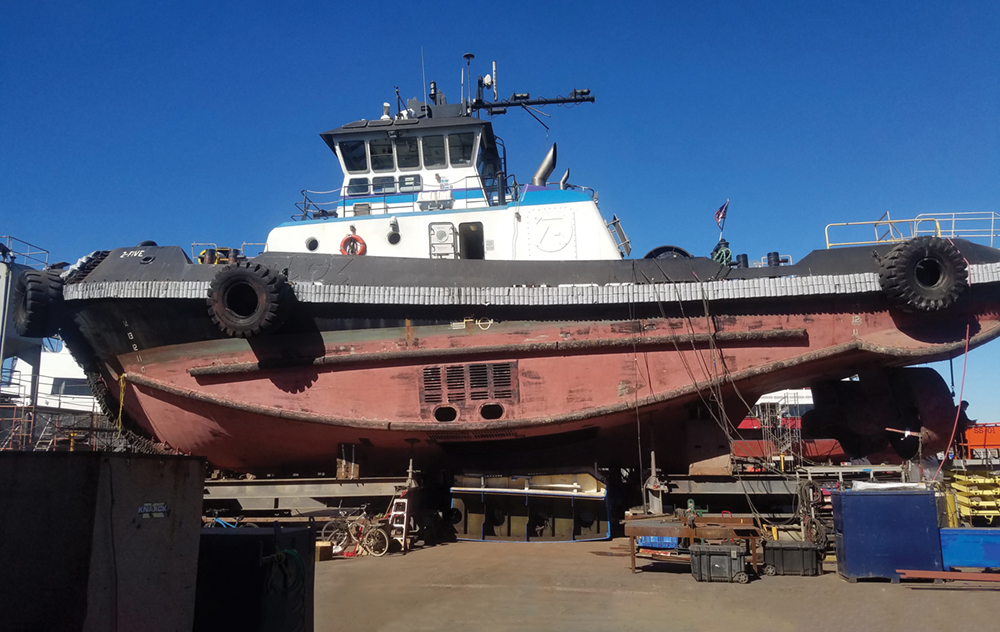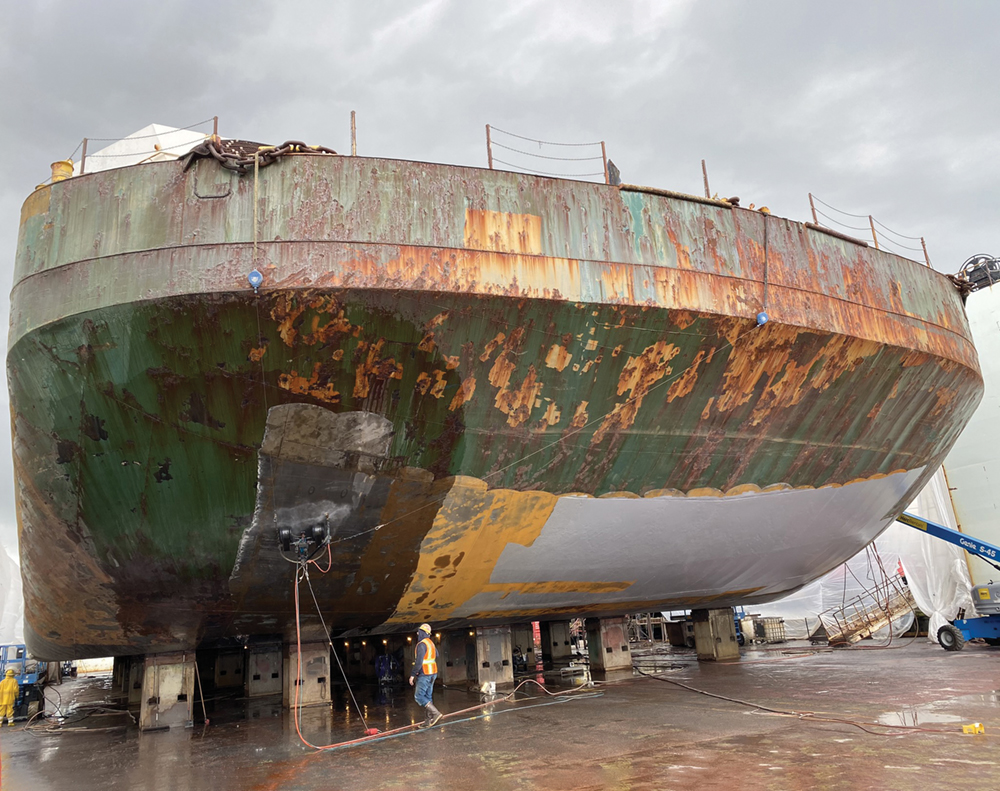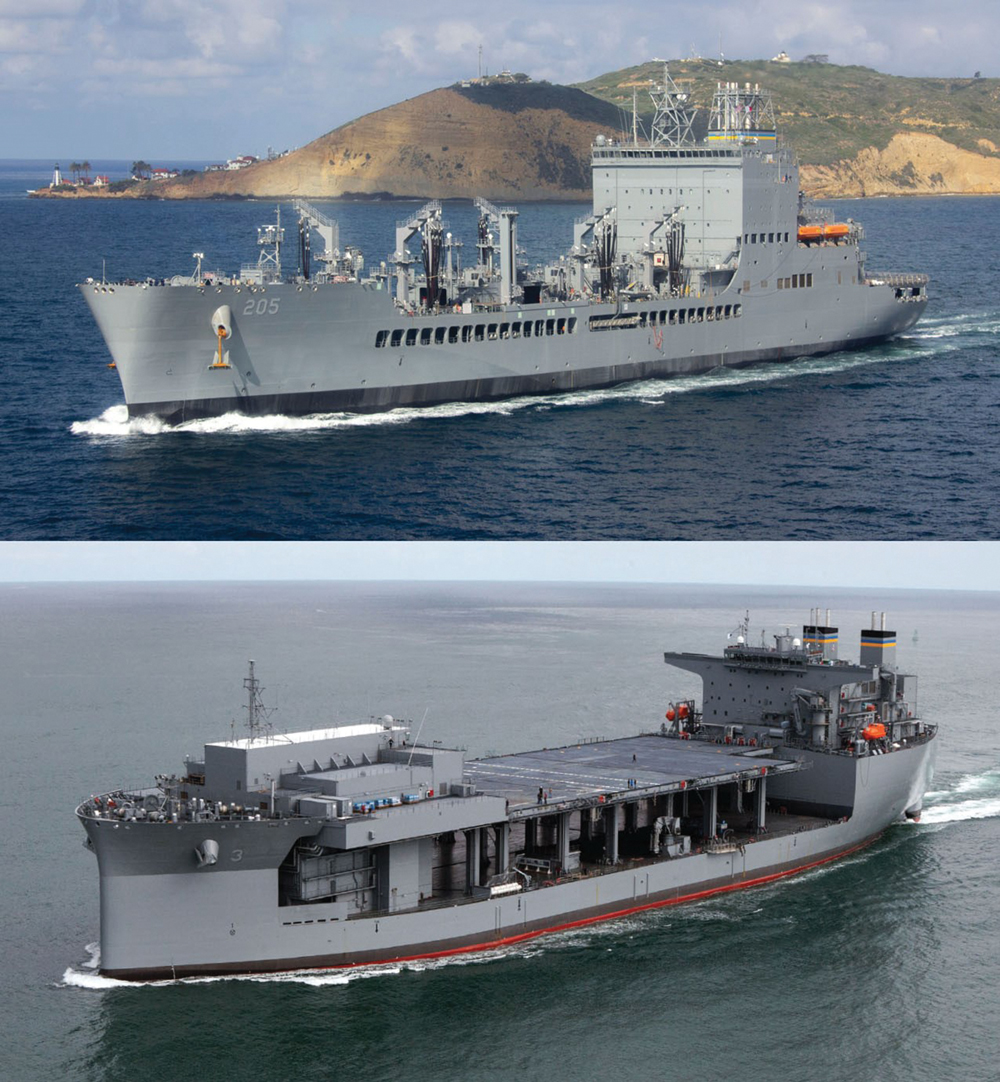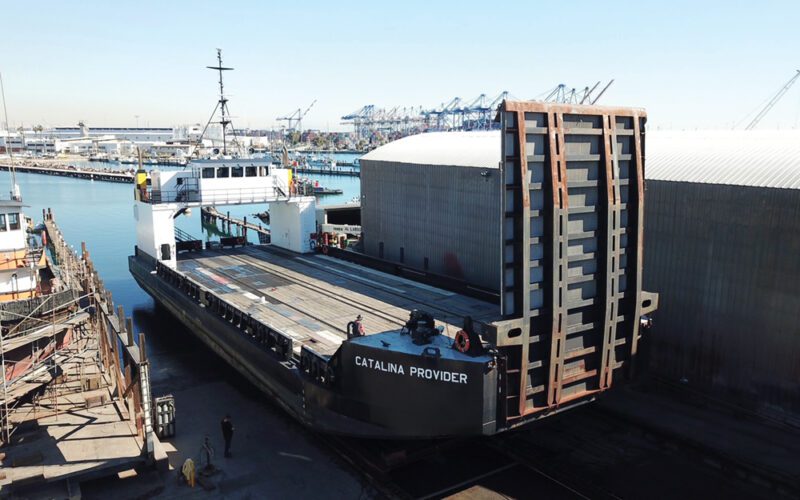
Whether it’s a ferry carrying passengers to work in the Bay Area or a U.S. Navy vessel supporting military missions in the Pacific, chances are that the vessel was designed, built and/or repaired by a West Coast shipyard.
Up and down the coast, there’s a bevy of craftspeople working on a number of major projects for public and private sector clients such as the National Oceanic and Atmospheric Administration, the U.S. Navy, Crowley Maritime, Foss Maritime and the cruise industry.
Here’s a look at the projects being worked on by a handful of West Coast companies.
AL LARSON BOAT SHOP
The longtime shipyard based in San Pedro Bay has been hard at work on major repair projects up and down the West Coast, Al Larson Boat Shop President Jack Wall said.
2022 has been very busy for the company, which recently completed two large welding jobs for Manson Construction on a pair of sister barges: the Northport and Eastport.
Both dump scows received a total of 105,000 pounds of combined new steel plating and internal structural replacement, as well as extensive preservation packages.
Manson Construction also has commissioned the shipyard on a repowering project. The yard is in the middle of working on the vessel Pup, an anchor-handling tug that has been getting a complete overhaul with new engines and extensive modifications, Wall said.
Al Larson Boat Shop has also finished several projects for Marine Spill Response Corporation, including routine maintenance of several vessels and barges such as MSRC’s 65-foot aluminum spill response boats and 200-foot barges.
The shipyard continues to serve its returning customers, including the Jankovich Company, which has had several barge dry dockings such as the Tyler J and Payton J. These fuel barges received water jetting preservation with new paint coatings, Wall said.
There also have been various dry dock projects for the dinner cruise industry, including Hornblower Cruises for its vessels Entertainer, Mojo, Just Dreaming and Icon. The shipyard also worked on Harbor Breeze Cruises’ vessel Sir Winston and Fantasea Yacht Charters’ vessel Dandena.
Returning tugboat companies such as Crowley Maritime, Foss Maritime, Sause Bros., Bay Delta, Centerline Logistics Corporation, Starlight Marine and Brusco Tug & Barge have been utilizing the shipyard’s services “in order to maintain our local fleet to be ready for services around the ports of Long Beach, Los Angeles and the Port of Hueneme,” Wall said.
The shipyard’s work also has benefited the local commercial and sport fishing fleet, including 10 dry dockings from vessels spanning from San Diego to Ventura, Wall said. Catalina Express was supported with drydocking for the vessels Starship, Catalina Express and Super Express. Catalina Island also sent two mooring floats to be refurbished.
The shipyard expects to be just as busy next year, Wall said.
“We have the first half of 2023 already booked with back-to-back tugboats in our drydock,” he said.
The shipyard recently secured another three-year contract with the Port of Long Beach Maintenance Department for work that would encompass its entire fleet. That includes the port’s two Voith-powered fireboats.
“Al Larson Boat Shop’s current workload looks steady for the rest of the year and the first half of 2023,” Wall said.

BAY SHIP & YACHT CO.
When Bill Elliott founded Bay Ship & Yacht (BSY) in 1977, it was a start-up that operated out of a mobile shipping container in the Bay Area.
Forty-five years later, the “Shipyard in a Box” has grown into a major maritime firm specializing in ship repair and refit for the public and private sector, including the Bay Area’s ferry system, network of barges, superyachts and other projects. The company now includes its main facility in Alameda, Svendsen’s Marine & Industrial Supply and Richmond, Calif.-based Svendsen’s Bay Marine, which specializes in commercial and recreational vessels.
As the company continues to evolve and grow, Bay Ship & Yacht founders Bill Elliott and Alan Cameron decided to step back earlier this year, promoting Assistant General Manager Gerona Goethe to general manager and Chief Naval Architect Joel Welter to chief executive officer.
The leadership change, according to the company, allows Elliott and Cameron to develop business opportunities outside of BSY with the various endeavors of Bay Maritime Corp.
For Bay Ship & Yacht, a big part of its success lies in its ability to serve customers and offer skilled craftsmanship and expertise on every project.
“The majority of BSY’s customers have a long-standing relationship with the yard,” spokesman Michael Stoecker said. “We have found that providing high quality work and ensuring that we live up to our motto of ‘Absolute Customer Satisfaction’ is the best way to develop repeat business.”
This year, the company has completed a number of projects, including a dry docking of the NOAA vessel r/v Fairweather, which involved extensive corrosion repairs, a full paint job and equipment upgrades.
“NOAA vessels are a good fit for our yard, both in size and typical job complexity,” Estimating and Contracts Manager Michael Kelley said. “They are a great customer to do business with.”
This company also worked on a “Tugz” class tug repower, the third repower for this vessel class. The trickiest part of the repower, Lead Design Engineer Frank Rogosich said, was finding a good machinery access path in and out of the vessel.
“The normal pathways, upwards or sideways, are blocked by accommodations and major systems installations,” he explained. “In this case, going through the vessel’s double bottom fuel tanks proved to be the most sensible option. We were also able to use our level land transfer system to move the whole boat sideways to facilitate the placement of engines and access cut-outs under the vessel.”
The company also completed many excursion boat dry dockings for routine U.S. Coast Guard certificates of inspection, including vessels from Hornblower Cruises, Alcatraz Cruises, Blue and Gold, Red and White and Commodore Cruises.
Currently, BSY is working on four Army vessels, which are undergoing major overhauls.
“We find that the Army is a great organization with which to do business,” Goethe said. “The vessels arrive with a very knowledgeable and experienced survey crew who is backed up by an excellent contracts and engineering group at headquarters. This combination leads to a competent and present customer ready to work with the yard.”
Meanwhile, Bay Ship & Yacht is working on plans for newly won contracts with NOAA and the U.S. Navy and is actively bidding jobs for the fourth quarter of this year and 2023.

EVERETT SHIP REPAIR
Three years ago, Everett Ship Repair (ESR) was created to serve the maritime industry on the West Coast.
Since then, the company—which is owned by Ice Cap Holding, LLC and is a sister firm of Nichols Brothers Boat Builders—has been busy building its business in the region.
In March, the company announced that it bought a pair of new 40,000psi ultra high-pressure water blasting systems, which have been sent to the shipyard and put to use as a cost efficient and sustainable alternative to abrasive solid blasting material, ESR said.
“This system allows ESR to deploy up to four water blasters simultaneously in a wide variety of applications including internal tank hydro blasting for cleaning and coatings removal,” the company said, adding that the new system reduces noise, labor, risk of personnel injury and waste stream created by traditional grit blasting.
ESR also plans to use the system outside of the shipyard, offering surface prep services for removing unwanted or contaminated surface materials and pipe and tank cleaning for customers.
In May, the company celebrated the opening and naming of its newest drydock, the Emerald Lifter.
The Emerald Lifter—which was named to honor the Puget Sound—did maintenance and preservation work as the Zidell 220 before moving to the company’s Port of Everett facility and going into service with its first drydocking, according to the company.
Its 2,000-ton lifting capacity and 220-foot by 62-foot working deck will go hand in hand with the facility and the company’s current 430-foot by 110-foot, 8,000-ton capacity dry dock Faithful Servant, which has been in operation since 2019.
Everett Ship Repair also obtained a 150-ton link belt crane positioned on a 180-foot by 49-foot barge from Nichols Brothers to serve both dry docks.
At the ribbon-cutting ceremony in May, Everett Ship Repair CEO Gavin Higgins said he was excited about the opportunities the new dry dock brings to the facility, including the local jobs it has the potential to generate and the skillsets it adds to further enhance the shipyard.
“We have built up our team over the last two years to approximately 80 full-time staff,” he said. “We look forward to the new dry dock grabbing the attention of local tradesmen as we can continue to grow our team and serve the industry in a larger capacity now with two dry docks.”
Port Director and CEO Lisa Lefeber lauded the company’s presence and its desire to expand.
“This has been a critical asset for our region” in keeping jobs and vessel repair here and supporting local commercial fishing, ferries and the Navy base, she said.

GENERAL DYNAMICS NASSCO
Thanks to a new $600 million award in U.S. Navy contract modifications, San Diego-based General Dynamics NASSCO has plans through 2027 to work on vessels in the John Lewis-class fleet oiler (T-AO) and the Expeditionary Sea Base (ESB) programs.
Construction is expected to begin in the third quarter of 2023 for the shipbuilder on lending the long lead-time material needed to construct the T-AO’s seventh and eighth vessels ($500 million) and ESB’s sixth vessel ($100 million), the company announced in June.
General Dynamics NASSCO President Dave Carver noted the honor of working on the vessels.
“The NASSCO team is excited to work with our Navy partners to ensure the success of both historic programs, which are critical in supporting the Navy’s forward presence,” he said.
The company is no stranger to the T-AO program, having designed the first six ships in the John Lewis-class, 742-foot vessels created to move fuel to U.S. Navy carrier strike group vessels at sea. T-AO vessels can carry as much as 157,000 barrels of oil and have a full load displacement of 49,850 tons, according to NASSCO.
Also, the company in late June christened the 784-foot USNS John L. Canley, the fourth ship in the Navy’s reclassified Expeditionary Sea Base (ESB) program, named after the Medal of Honor recipient. Canley in 1968 rescued more than 20 Marines under enemy fire during the Battle of Huế City in Vietnam. He was also given the Bronze Star with Combat “V” and the Purple Heart.
“This ship represents his courage, selflessness and strength,” Carver said at the ceremony. “On behalf of the 3,500 men and women of General Dynamics NASSCO, I am proud to present the USNS John L. Canley for christening.”
ESB vessels are mobile sea bases with platforms created to support various missions including Air Mine Counter Measures and Special Operations Forces, according to the company.
The USNS John L. Canley has a 52,000 square-foot flight deck that can help MH-53, MH-60, MV-22 tilt-rotor and H1 aircraft operations.
Meanwhile, the seventh vessel in the ESB program, the USNS Robert E. Simanek, is under construction.
PACIFIC FISHERMEN SHIPYARD
Washington-based Pacific Fishermen Shipyard and PFI Marine Electric recently commemorated their 75th anniversary with the retirement of Doug Dixon as general manager and the appointment of Chris Johnson. This coincided with the 150th anniversary in Ballard’s Salmon Bay of Norwegian heritage shipbuilders at T.W. Lake’s shipyard and the old Ballard Marine Railway.
The company also received a $556,000 grant from the U.S. Department of Transportation’s Maritime Administration. The money is expected to fund FYE 2022 capital improvements to the yard’s drydocks.
The No. 2 marine railway is being modified to service fishing vessels with sponsons and the new, wider Kitsap County fast ferries, the company said.
Meanwhile, the No. 3 Rowe lift dock is being converted from a 350 Chevy V-8 engine that ran on propane to an electric motor drive with 20 lift gearbox rebuilds, which lowers the company’s fossil fuel usage.
Drydock capability was down during the dredging of the No. 3 Rowe lift dock in which 3,000 cubic yards of contaminated sediment was removed. This sediment accumulated over the years mainly from Seattle’s upstream sewage outfall from Sunset Hill at the foot of 24th Avenue NW, the company said.
A two-foot sand cap was put on to prevent further leaching.
“While this dredging activity was a necessary and ecologically responsible maintenance item, it also increased drydock draft capacity from an impaired 10 feet back to the original design 15-foot depth,” the company said.
The shipyard also has been busy with drydocking, engine changeouts and electrical work in Seattle and at its shop in Dutch Harbor. The vessels include North Sea, Ocean Leader, 4 Daughters, Sea Storm, Green Hope, Southern Wind, Columbia, Polar Sea, Marcy J. Arcturus, Pacific Mariner, Early Dawn, Northwestern, Billikin, Lilli Ann, Kirsten Marie, Northern Ram, American Beauty, Pacific Challenger, Elsie M, Lorelei, Pacific Wind, Arctic Bear, Aldebran, Pacific Viking, Royal Viking, Royal Atlantic, Nordic Mariner, Wizard, Oceanix, Erla N, Mary B, Angie, Commodore, Starbound and Starfish.
VIGOR
Last spring, Vigor finished its biggest project to date: modernizing the USS McCampbell, an Arleigh Burke-class guided-missile destroyer, at its Swan Island facility in Portland, Oregon.
The project took 18 months and more than $155 million to complete before delivering the vessel to its new homeport at Naval Station Everett. About 250 Vigor employees, contractors and Navy service members worked on the project, which involved hull improvements, updates to mechanical and electrical technology and critical warfighting improvements.
“Our skilled workers at Swan Island were honored to support the U.S. Navy and get USS McCampbell back into service,” said Adam Beck, the company’s executive vice president of ship repair. “This was the largest and one of the most complex projects our ship repair workers have ever completed. It says a tremendous amount about the skill and dedication of our workers throughout the process, and their ability to rise to the occasion on these major projects.”
The USS McCampbell is the latest in a series of the company’s recent wins, which have included working on the USS William P. Lawrence and USS Wayne E. Meyer in Hawaii and the USS Coronado and USNS Mercy at Swan Island.
Meanwhile, Vigor is conducting maintenance and modernization work on the USS Chosin at its Harbor Island facility. The company also is expected to start work on the USS Tulsa when it arrives in Portland this month.
“Our skilled workers keep stepping up on these projects of increasing complexity,” Beck said. “Specifically on USS McCampbell, they came to work every day throughout the pandemic, adhering to health protocols and consistently bringing their best efforts to get this vessel back in service for our Navy customer.”
In May, the company’s facilities in Ketchikan, Vancouver, Swan Island and Hawaii netted recognition from the Shipbuilders Council of America of safety performance last year. All four facilities scored the “Excellence in Safety Award.”
Vigor’s Hawaii team garnered the “Significance in Safety Achievement” Award, one of four in the country to obtain the honor bestowed on shipyards with zero fatalities and a total recordable incident rate of under 1.0.
“This recognition is a testament to the incredible effort of our skilled workers to be safe every day,” CEO Jim Marcotuli said. “Our top priority is ensuring each person who comes to one of our work sites leaves the same way they arrived, by anticipating and preventing hazards.”
KAREN ROBES MEEKS, a Southern California native, is an award-winning journalist with more than 20 years’ writing experience. Her articles have appeared in the Los Angeles Times, San Francisco Chronicle, Orange County Register and Long Beach Press-Telegram, where she worked as a reporter for nearly 14 years. Her work has been recognized by the California News Publishers Association, the Associated Press News Executives Council and the Los Angeles Press Club.

